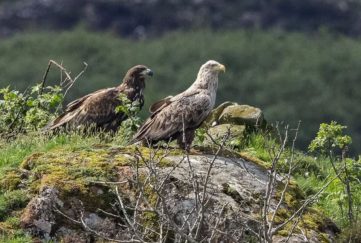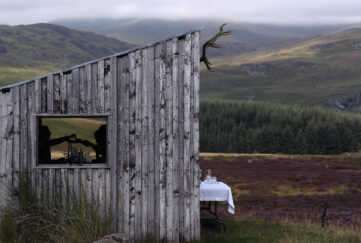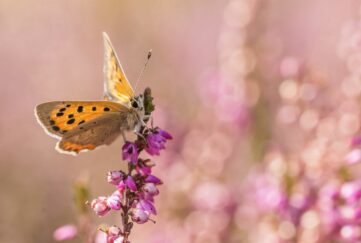Hypnotic Hen Harriers – Jim Crumley
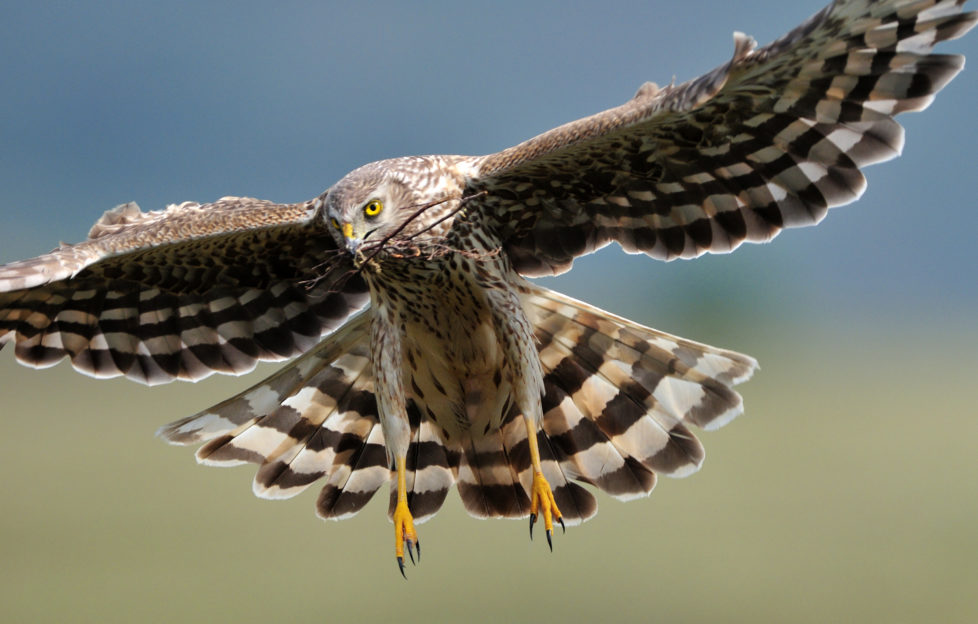
 These mesmerising birds of prey are under threat due to unnatural grouse moors…
These mesmerising birds of prey are under threat due to unnatural grouse moors…
SNOW in August, drifting down from the north-facing flanks of the western end of the Ochil Hills, the slopes aglow in warm evening sunlight and shining green as emeralds.
Somehow the slopes never look like themselves when they wear that summer sheen, but hey…wait a minute, you said snow in August, then you said warm evening sunlight? How can there possibly be snow drifting down when it’s early August and the day is warm?
But look, up there, crossing the gully and slipping sideways and diving down like a snowball on the rampage, those are the colours of snow on the move, a fragment of avalanche.
Sometimes you run out of metaphors for hen harriers, especially the snow-shaded male of the species. Judging on pure aesthetics, few creatures in the many landscapes of Scotland are so designed to leave you rooted and breathless, pent-up with a kind of primitive wonder.
For some keepers with guns, however, your job might not allow you the luxury of primitive wonder, and the only good harrier is a dead harrier.
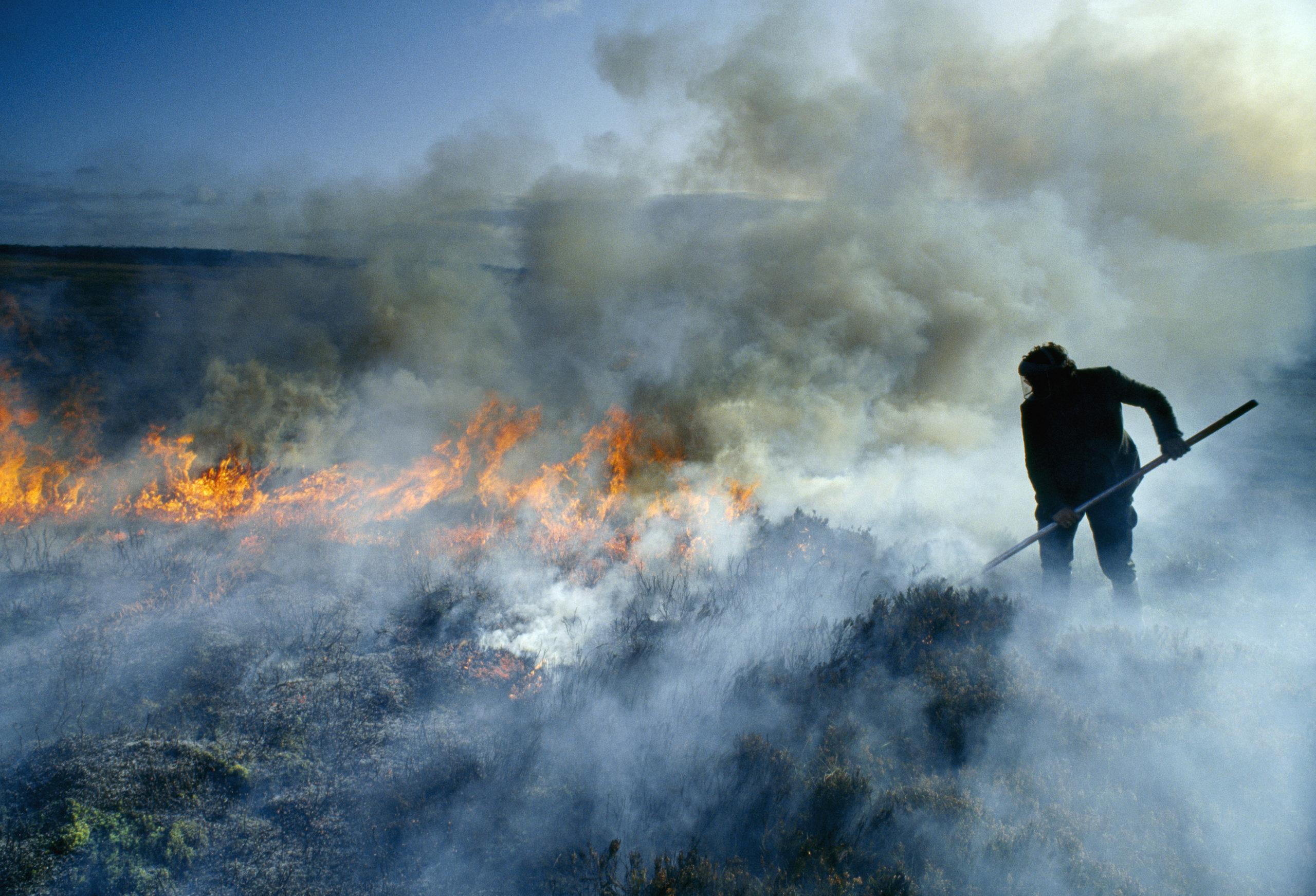
Muirburning, moorland management Lammermuirs, Berwickshire, Scotland, March 1993.
There are certain places in Scotland that have a track record for making birds of prey disappear, up to and including eagles – almost always in parts of the country obsessed with grouse shooting.
They protest every time some wildlife organisation or other goes public about the demise of one more harrier. They’ll tell you that when satellite tags suddenly stop working, it could be because the tag failed – they hardly ever do – and there’s no proof the bird has been illegally killed. That is often true as it’s rare that the corpse is ever found – they have become adept at disposing of dead harriers and eagles.
But in the case of the hen harrier, the weight of circumstantial evidence is huge and it’s also historic. Making hen harriers disappear is nothing new.
At the beginning of the 20th century, they had been eliminated from mainland Scotland, by men with guns, and only survived in any numbers in Orkney. The great paradox of their subsequent revival is that without the respite from grouse shooting during the two world wars – when most keepers were away fighting – it might never have happened.
Such was the difference in the way grouse moors were treated in wartime, that by 1946 harriers were breeding throughout the mainland once more. That population boost was strengthened by the spread of new plantation forestry into the 1970s, with the attendant bounties of voles and small birds in the first years of the new forests.
But the rationale behind killing harriers is always the same, although it is now illegal and has been since the Protection of Birds Act of 1954. Harriers are killed because some believe they kill too many young grouse.
And they need as many grouse as possible so that rich, privileged people with guns can kill them. Why? Because the rich and privileged pay good money to do it – and they do it because they enjoy killing things with guns. The birds also fetch good prices in London restaurants, and so – wait for it – “it’s good for the rural economy”.
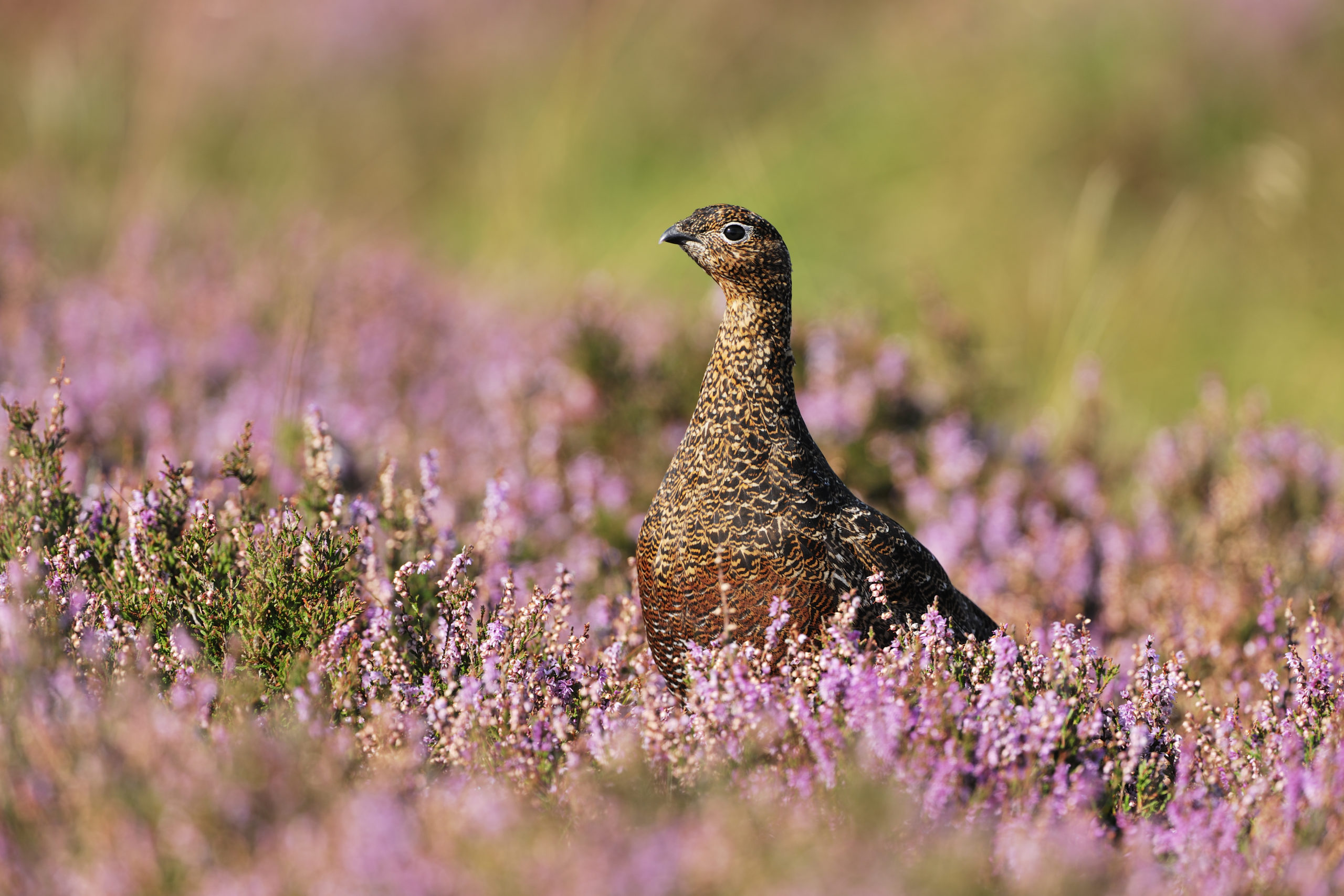
Red Grouse. Pic redit: L.Campbell
So that’s all right then.
That is the arrogance that underpins certain landowners’ assumption that they and they alone have the right to decide which species should live and which should die – because it’s good for the rural economy. That arrogance is the rock on which Scottish land management practice founders, and birds like the hen harrier founder with it.
The licensing of grouse moors is finally creeping on to the lower echelons of the political agenda and pressure is growing for our parliament to create a system tailor-made for the Scottish situation – drawing on successful schemes already in place elsewhere in Europe.
In the meantime, wild grouse are being fed medicated grit, moors are being ravaged by muir-burning, mountain hares are being killed in vast numbers because of the perceived risk of tick infection from hare to grouse. Yet for thousands of years, before the notion of a grouse moor was invented, the mountain hare, the red grouse, and for that matter the unburned moor, and yes, the hen harriers and golden eagles, all thrived side by side.
But people seem to like killing hares with guns too.
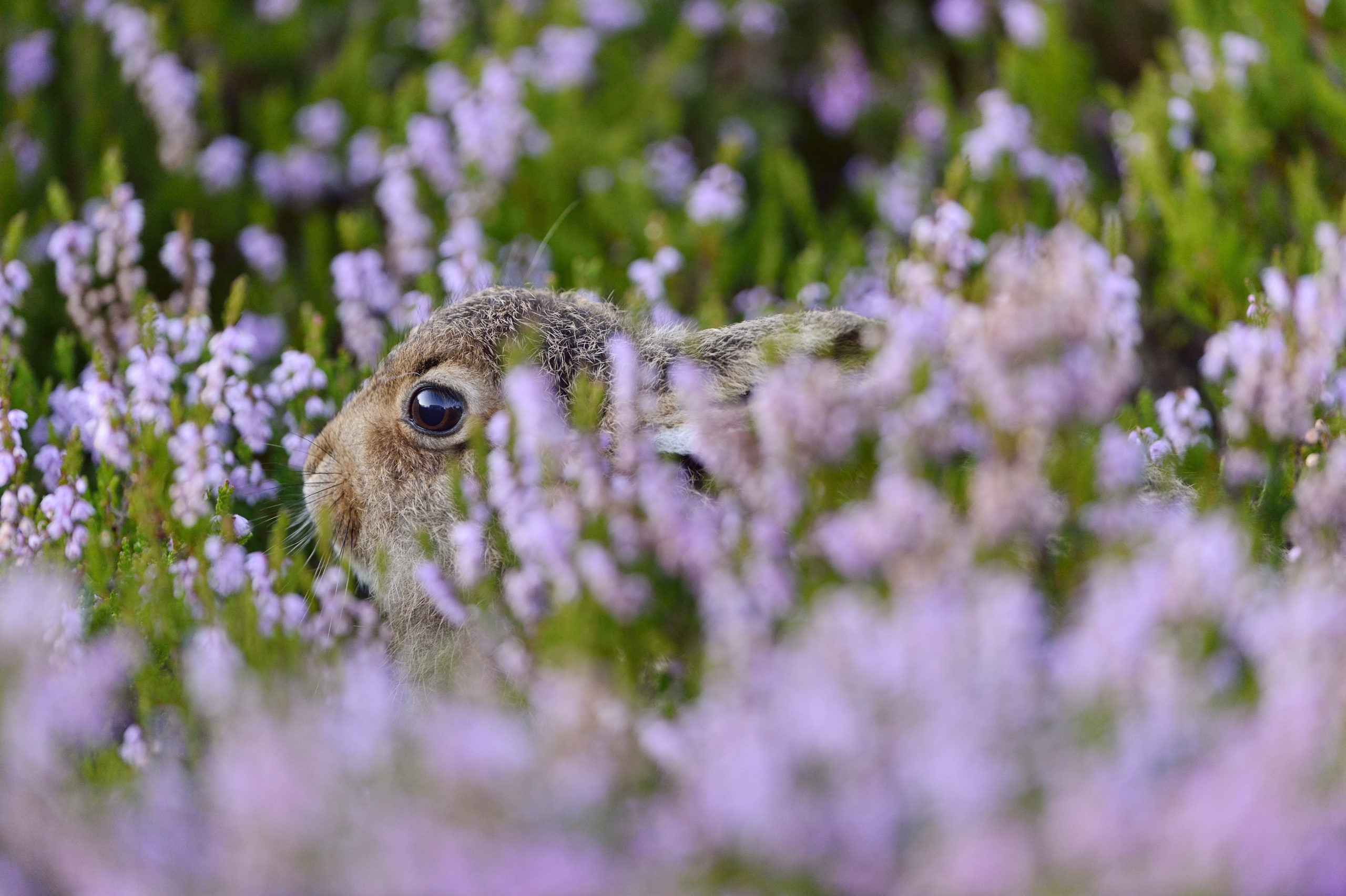
Mountain Hare. Pic credit: L. Campbell
This is what is happening to the land we know as a grouse moor, when in fact it’s just a moor that has been tampered with for centuries. Left to its own devices, it would quickly recover to a mix of heather and woodland, biodiversity would soar and grouse numbers would recover – with no grouse requiring medicated grit.
Meanwhile, on a north-facing slope of the Ochil Hills, where the high summer hill grass was long and stippled with wild flowers, and still-singing skylarks were scattered across their airy perches, and sand martins and meadow pipits fizzed through the warm air, the ever-so-slightly eerie owl face of the hunting harrier lifted from a long, slow scrutiny of the grass a yard beneath its wings.
The bird rose and banked, undersides glittering white in the sunlight – and it might be that you have been so distracted by the exquisite fluidity of the blue-grey-white upper feathers that you missed the ink black primary feathers, that sublime final flourish to the extraordinary finery that is the male hen harrier’s plumage.
The harrier gathered speed across the hillside, ignoring the small bird hordes for the moment, although it is a comparatively easy task for the harrier to snatch a skylark from the summit of its ascent or a pipit from its gleeful tail-up glide back to earth.
Instead the harrier curved into the tightest of tight turns, stalled, held up dead still against the pushy little breeze, dropped back down until it almost met its shadow, and resumed that inchingly-slow, low stalk, owl face riveted on the next yard of grass, the next, the next.
The whole poised process is hypnotic, and – as long as you don’t analyse in too much detail what is actually going on, its lethal denouement – undeniably beautiful.
The two ecstatic lines that slipped effortlessly into mind were written not for a hen harrier, but for a kestrel. They occur in Gerard Manley Hopkins’s poem, The Windhover, but they fitted well enough that August day into the rituals of bird and bird-watching nature writer,
…My heart in hiding
Stirred for a bird – the achieve of, the mastery of
the thing!
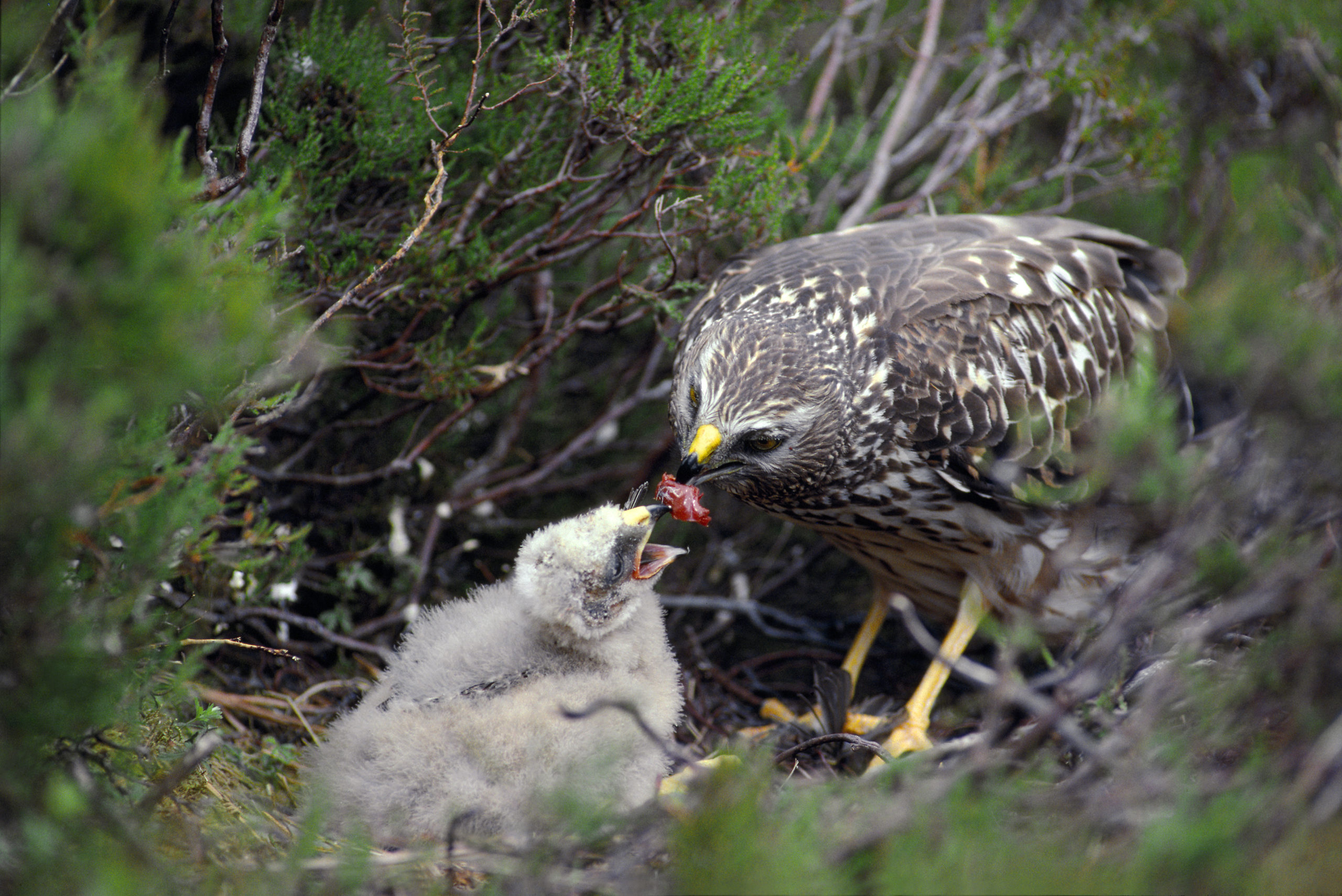
Female Hen Harrier with young at nest on moorland. Pic credit: L. Campbell
I let those words linger in my head for a while, admiring the poet’s daring, especially the way he made more out of the word “achievement” by slicing the end of it. Then I fancied I could hear a different voice.
The greatest friend I ever knew, artist George Garson, would utter his own mantra, a form of words that underpinned his art – head of mosaic and stained glass at Glasgow School of Art, and in the late years of his life, a return to painting and drawing – “Control, control, control… but relaxed control, mind.”
He brought that mantra to bear whenever he was trying to make a point about anything he admired, from a symphony to a poem, to the lie of a landscape under his drawing hand. And now I borrowed it and I could see him nodding his approval and muttering, “Aye, Jim”.
So “my heart stirred for a bird” and “relaxed control” caught the essence of that bird’s flight. It is the nature writer’s condition, always reaching for words – your own or someone else’s – to hold on to the sight before you.
Hen harriers are glider-shaped, all wings and tail, no fuselage, pencil-slim. For the next half-hour, that glider-bird quartered the hillside, the speed of the flight occasionally dropped to a barely credible slowness.
Where does the lift come from to keep the creature airborne when it is no more than a few inches or a foot above landing height? Relaxed control at its utmost, the relentlessness of the pattern changing only to thrust down into the grass. Two strikes out of four, two voles consumed. Then the relentlessness resumed.
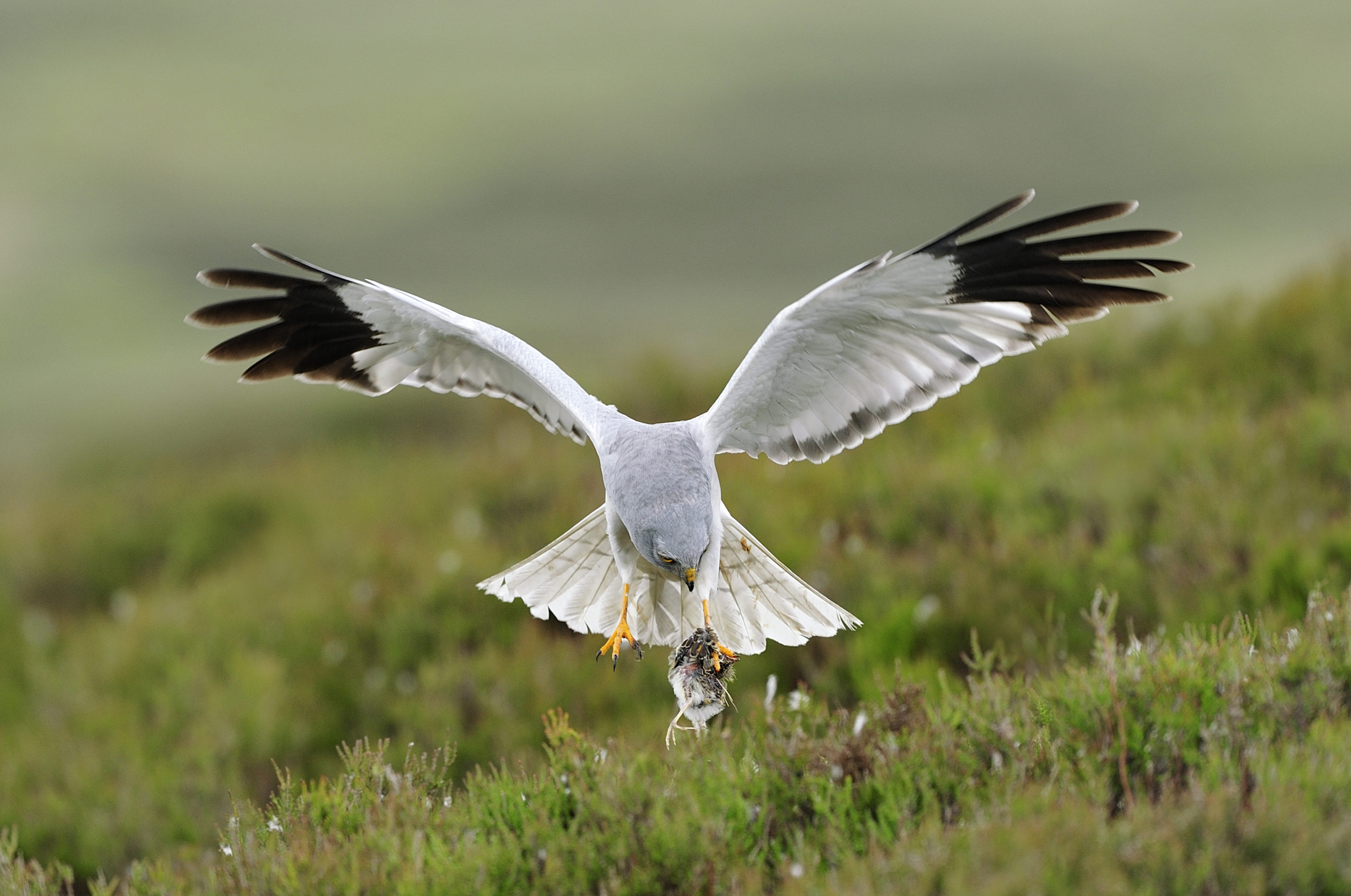
Hen Harrier. Pic credit: L. Campbell
I have watched hen harriers from Orkney to Skye, from the Insh Marshes to Mull, from the Borders to Arran, and nearer home from Flanders Moss to Glen Finglas to this edge of the Ochil Hills.
But they are scarce enough on the face of the land, and they are so, so watchable, that they make every sighting an event.
Hen harriers are ground nesters, so they lose chicks to mammal predators, notably foxes. Studies suggest an average of between five and 10% of broods can be affected, and species populations can live with that.
But on some grouse moors, where fox control is diligently practiced to say the least, the comparable figure is nearer 80% of nests. Here the predator is likely two-legged, uses guns, night-time lamping and heat-seeking equipment to find the birds at the nest or in communal winter roosts.
The grouse moor industry accounted for the mainland extinction of hen harriers once before. It’s not exaggerating the effects of current practice to suggest that without a drastic reappraisal of land ownership, and a much tighter rein on the ethics of grouse shooting, a second extinction could be just under the horizon.
So these are precious encounters for a nature writer.
A few months ago I watched a pair of hen harriers at Flanders Moss, perched on adjacent fence posts. One flew a few yards and perched again a couple of posts to the west. The second followed suit. There was a long pause, then it happened again … pause … then again … pause … and again and again. I guessed it was an alternative to the low, slow flying stalking technique, now made awkward by new growth of birch scrub.
Every pause was spent staring at the grass just beyond the fence. Now when I go to the Moss I check the fence posts, and although I’ve seen harriers, I’ve never seen that particular tactic again. Was it just a game?
Watching hen harriers is never less than mesmerising. There is always something different, something that finally answers an old question, something that reinforces my sense that the hen harrier is among the most rewarding creatures of nature to watch in a Scottish landscape and that its survival is infinitely more important than the survival of the perversion of land use that is the grouse estate – and that what’s good for the rural economy has nothing to do with it.
You can read more of Jim Crumley’s Scottish wildlife columns online here, and each month in The Scots Magazine.
Subscribe to The Scots Magazine today for more from Jim Crumely >>



